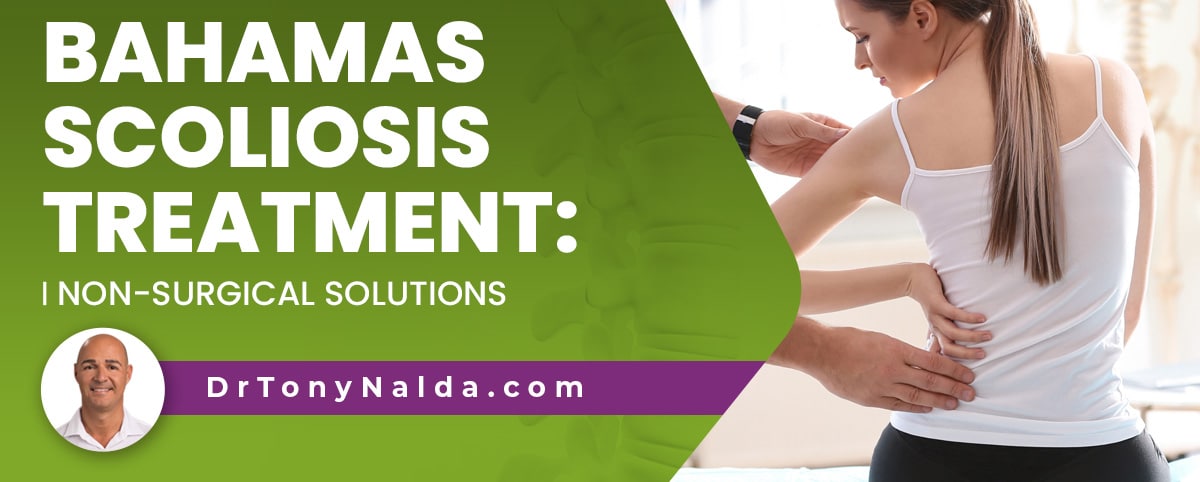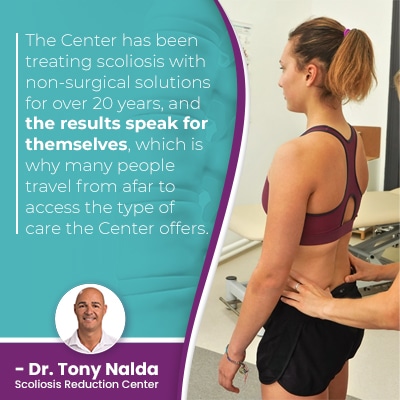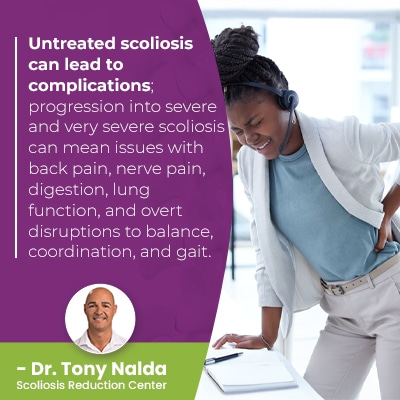Bahamas Scoliosis Treatment: Non-Surgical Solutions

There are different ways to respond to a diagnosis of scoliosis: with proactive conservative treatment, traditional surgical treatment, or leaving it untreated. Let's explore how each response can shape long-term spinal health.
Bahamas scoliosis treatment can include Orlando, Florida's Scoliosis Reduction Center with a 1.5 hour flight. The Center is known for its innovative non-surgical scoliosis treatment solutions and impressive results.
Not everyone has access to equal medical care, and scoliosis is a highly-prevalent spinal condition that can always benefit from treatment.
Table of Contents
What is Scoliosis?
Scoliosis is a highly-prevalent structural spinal condition that causes the spine to bend to the side unnaturally and rotate.
As a progressive condition, the nature of scoliosis is to get worse over time, and this involves the spine's unnatural curve and twist getting worse over time.
Progression makes the spine increasingly rigid and less responsive to treatment, hence the benefit of responding to a diagnosis with immediate treatment, but not all types of treatment offer the same types of results.
Scoliosis affects all ages and has different types and severity levels.
Residents of the Bahamas can access non-surgical scoliosis treatment designed by renowned Dr. Tony Nalda of the Scoliosis Reduction Center® with a 1.5-hour flight to Orlando, Florida.
 The Center has been treating scoliosis with non-surgical solutions for over 20 years, and the results speak for themselves, which is why many people travel from afar to access the type of care the Center offers.
The Center has been treating scoliosis with non-surgical solutions for over 20 years, and the results speak for themselves, which is why many people travel from afar to access the type of care the Center offers.
The most important decision a patient recently diagnosed has to make is how to treat their condition because different treatment plans offer different potential results, so let's start with how conservative treatment affects spinal health.
Conservative Scoliosis Treatment and Spinal Health
The benefits of conservative non-surgical scoliosis treatment are many, but the main benefit is how the approach preserves as much of the spine's natural strength and function as possible.
Conservative treatment is integrative so combines the power of multiple different types of scoliosis treatment so conditions can be impacted on every level.
Conservative treatment combines the power of condition-specific chiropractic care, physical therapy, scoliosis specialized exercises, corrective bracing, and rehabilitation.
Spinal health is important for quality of life, so how a scoliotic spine is treated can shape its future health and function.
Spinal function refers to the spine's ability to stay flexible and maintain a wide range of motion, stay strong and resistant to injury, and its ability to work with the brain to facilitate brain-body communication.
The Center's multi-faceted treatment approach means that patients can benefit from accessing different types of treatment under one roof, so for patients who travel from the Bahamas in search of scoliosis treatment, a benefit is accessibility.
As a structural spinal condition, scoliosis has to, first and foremost, be impacted on a structural level, and this involves condition-specific chiropractic care.
Conservative Treatment is Chiropractic-Centered
Conservative treatment can also be referred to as functional treatment and/or chiropractic-centered treatment because its main goal is to preserve the spine's natural function and strength.
Conservative treatment offers a safer, more natural, and less invasive treatment option than traditional surgical treatment, and chiropractic care is at the heart of the approach.
Condition-specific chiropractic care can include a number of techniques and manual adjustments that work together to address areas where the spine is not aligned as it should be.
Manual adjustments can work towards adjusting the position of the curve's most-tilted vertebrae at its apex back into alignment with the rest of the spine; this is adjusting the spine's structure and impacting the condition's underlying structural nature.
Once the alignment of the tilted vertebrae have been improved, different facets of treatment are then applied to hold those structural results, and this involves the spine's surrounding muscles.
Physical Therapy and Specialized Scoliosis Exercises
When significant progression has occurred prior to the start of treatment, spinal rigidity can be an issue; not only does it make the spine less responsive to chiropractic care, it can also make it difficult for patients to perform key therapeutic exercises as part of treatment.
Physical therapy and specialized scoliosis exercises can help restore a baseline level of spinal flexibility to prepare the spine, and its surroundings, for treatment.
Physical therapy can help sustain structural treatment results by increasing core strength so the spine's surrounding muscles are stronger and better able to support and stabilize the spine; it's not just the spine that has to maintain its natural curves and alignment, but also the musculature surrounding the spine.
Physical therapy can mean stronger muscles to support the spine, and it can also be used to address any related muscular imbalance; restoring muscle strength, balance, and improving posture are all within the power of physical therapy that's scoliosis-specific and customized.
Physical therapy can also help activate brain-body communication by stimulating certain areas of the brain.
While no single type of treatment will be enough to impact scoliosis on all levels, when integrated into proactive treatment plans, different disciplines can complement one another.
Corrective Bracing
For childhood scoliosis treatment, corrective bracing is a regular facet of treatment that can help by pushing the spine into a corrective position.
Corrective bracing can be particularly effective when treating childhood scoliosis because as the spine is still growing, it's more malleable and can be pushed into a healthier position.
When combined with other types of corrective treatment, bracing can augment corrective treatment results.
Rehabilitation
Rehabilitation is about continuing to heal and stabilize the spine for long-term sustainable treatment results.
Continued chiropractic care can be important, as can a series of custom-prescribed home exercises so patients can easily continue to heal and stabilize the spine from home.
Surgical Scoliosis Treatment and Spinal Health
Scoliosis surgery is a type of spinal fusion, and like all surgical procedures, spinal fusion comes with its share of risks.
Spinal fusion is a costly, invasive, and risky spinal surgery that involves fusing the curve's most-tilted vertebrae into one solid bone and attaching rods to the spine to hold it in place.
While surgical intervention can successfully straighten a bent spine, the way it does so is contrary to the spine's movement-based design so can cost the spine in terms of its overall strength and function.
The procedure itself comes with the risk of infection, nerve damage, excessive blood loss, and adverse reaction to hardware used.
While not a common complication, hardware can break and/or malfunction over time, and the only recourse is more surgeries, and the risks only increase with each subsequent procedure and increasing age.
 It's the long-term effects of spinal fusion that most concern me as many patients find a noticeable loss in spinal flexibility and range of motion, while others experience more back pain due to spinal rigidity.
It's the long-term effects of spinal fusion that most concern me as many patients find a noticeable loss in spinal flexibility and range of motion, while others experience more back pain due to spinal rigidity.
A fused spine is weaker and more vulnerable to injury, and this knowledge can also have a psychological effect as some patients are fearful of trying new things and/or participating in a variety of sports and activities.
Surgical treatments for scoliosis are not as safe and natural as a non-surgical treatment plan.
Untreated Scoliosis and Spinal Health
As a progressive spinal condition, the best time to start scoliosis treatment is always now.
Particularly if scoliosis is left untreated, it's virtually guaranteed to get worse at some point, and the more scoliosis progresses, the more difficult it is to treat, and the more severe a condition is, the more it is to continue progressing.
Untreated scoliosis can lead to complications; progression into severe and very severe scoliosis can mean issues with back pain, nerve pain, digestion, lung function, and overt disruptions to balance, coordination, and gait.
Conclusion
Those interested in Bahamas scoliosis treatment can access what the Scoliosis Reduction Center® has to offer within a 1.5 hour flight to Orlando, Florida, and Florida has many additional attractions that make the distance worth the effort from Disney World to SeaWorld.
For people recently diagnosed with scoliosis, it's important to be aware of all treatment options available, rather than being only presented with one and being funneled in the direction of surgery.
The goal of conservative non-surgical scoliosis treatment is to reduce the size of the unnatural spinal curve, counteract the condition's progressive nature, minimize its effects, and help patients avoid the hardships associated with invasive spinal surgery.
Through combining the power of chiropractic care, physical therapy, physiotherapy, scoliosis exercises, corrective bracing and rehabilitation, conditions can be impacted on multiple levels.
The best treatment plan for scoliosis is one that's aligned with the patient's desired outcome; for those wanting to restore function, relieve pain, improve range of motion in the spine, and avoid surgery, non-surgical management of scoliosis has a number of benefits.
A conservative program will use exercise and strengthening exercises to make the spine's surrounding muscles stronger and more supportive, chiropractic care to work towards curve reductions, and good posture to improve whole body positioning.
It can be worth traveling to access a certain treatment provider's approach, skill, and experience, and when it comes to scoliosis, as treatment is about how best to manage a lifelong condition, the type of treatment applied can shape a person's spinal health and quality of life.
Dr. Tony Nalda is a renowned non-surgical scoliosis treatment provider who is trained in many different treatment modalities, and once a patient of the Center, no more travel is needed as patients benefit from accessing multiple different types of treatment under one roof.
If you are out of state, or even country, and wondering if conservative scoliosis treatment is for you, don't hesitate to reach out for guidance and support.
Dr. Tony Nalda
DOCTOR OF CHIROPRACTIC
After receiving an undergraduate degree in psychology and his Doctorate of Chiropractic from Life University, Dr. Nalda settled in Celebration, Florida and proceeded to build one of Central Florida’s most successful chiropractic clinics.
His experience with patients suffering from scoliosis, and the confusion and frustration they faced, led him to seek a specialty in scoliosis care. In 2006 he completed his Intensive Care Certification from CLEAR Institute, a leading scoliosis educational and certification center.
About Dr. Tony Nalda
 Ready to explore scoliosis treatment? Contact Us Now
Ready to explore scoliosis treatment? Contact Us Now





